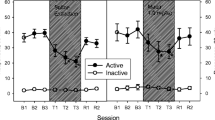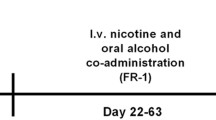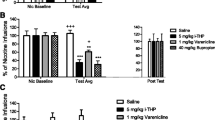Abstract
Rationale and objective
The mechanisms underlying the therapeutic efficacy of bupropion as a smoking cessation agent are unknown. Bupropion inhibits monoamine uptake as well as neuronal nicotinic receptor (nAChR) function. The present study compared effects of bupropion on nicotine self-administration to those of other stimulant drugs (methamphetamine and apomorphine) that lack nAChR activity in order to determine its mechanism of action. To determine the specificity of bupropion-induced changes in nicotine self-administration, the ability of bupropion to alter sucrose-maintained responding or amphetamine self-administration was determined.
Methods
In nicotine and amphetamine self-administration and sucrose-maintained responding experiments, rats responded for nicotine (0.01 or 0.02 mg/kg per infusion, IV), amphetamine (0.2 mg/kg per infusion, IV) and sucrose pellets (45 mg), respectively, on a fixed ratio 5 schedule. Once responding stabilized, rats were pretreated 15 min before the session with bupropion (1–78 mg/kg) or vehicle. The ability of methamphetamine (0.3–3 mg/kg) or apomorphine (0.01–0.2 mg/kg) to alter responding for nicotine (0.02 mg/kg per infusion, IV) was determined.
Results
Bupropion produced a biphasic dose-response pattern at both nicotine infusion doses, increasing infusions at low bupropion doses and decreasing infusions at high bupropion doses. Methamphetamine produced a similar biphasic pattern, whereas apomorphine only decreased nicotine infusions at high doses. Bupropion dose-dependently decreased responding for sucrose and amphetamine.
Conclusions
These results suggest that high bupropion doses decrease responding nonspecifically; whereas low bupropion doses selectively increase responding for nicotine. The increase in nicotine self-administration is likely due to inhibition of dopamine and norepinephrine transporters, combined with inhibition of nAChRs.





Similar content being viewed by others
References
Andersen PH, Jansen JA (1990) Dopamine receptor agonists: selectivity and dopamine D1 receptor efficacy. Eur J Pharmacol [Mol Pharmacol Sect] 188:335–347
Ascher JA, Cole JO, Colin JN, Feighner JP, Ferris RM, Fibiger HC, Golden RN, Martin P, Potter WZ, Richelson E, Sulser F (1995) Bupropion: a review of its mechanism of antidepressant activity. J Clin Psychiatry 56:395–401
Balfour DJK, Benwell MEM (1993) The role of brain dopamine systems in the psychopharmacological responses to nicotine. Asia Pac J Pharmacol 8:153–167
Bardo MT, Green TA, Crooks PA, Dwoskin LP (1999) Nornicotine is self-administered intravenously by rats. Psychopharmacology 146:290–296
Chavez-Noriega LE, Crona JH, Washburn MS, Urrutia A, Elliott KJ and Johnston EC (1997) Pharmacological characterization of recombinant human neuronal nicotinic acetylcholine receptors hα2β2, hα2β4, hα3β2, hα3β4, hα4β2, hα4β4, and hα7 expressed in Xenopus oocytes. J Pharmacol Exp Ther 280:346–356
Cooper BR, Wang CM, Cox RF, Norton R, Shea V, Ferris RM (1994) Evidence that the acute behavioral and electrophysiological effects of bupropion (Wellbutrin®) are mediated by a noradrenergic mechanism. Neuropsychopharmacology 11:133–141
Corrigall WA, Coen KM (1989) Nicotine maintains robust self-administration in rats on a limited access schedule. Psychopharmacology 99:473–478
Cousins MS, Stamat HM, de Wit H (2001) Acute doses of d-amphetamine and bupropion increase cigarette smoking. Psychopharmacology 157:243–253
Ferris RM, Cooper BR, Maxwell RA (1983) Studies of bupropion's mechanism of antidepressant activity. J Clin Psychiatry 44:74–78
Ferry LH, Robbins AS, Scariati PD, Masterson A, Abbey DE, Burchette RJ (1992) Enhancement of smoking cessation using the antidepressant bupropion hydrochloride. Circulation 86:167
Fryer JD, Lukas RJ (1999) Noncompetitive functional inhibition at diverse, human nicotinic acetylcholine receptor subtypes by bupropion, phencyclidine and ibogaine. J Pharmacol Exp Ther 288:88–92
Griffith JD, Carina J, Griffith C, Miller LL (1983) Bupropion: clinical assay for amphetamine-like abuse potential. J Clin Psychiatry 45:206–208
Goldstein MG (1998) Bupropion sustained release and smoking cessation. J Clin Psychiatry 59:66–72
Heal DJ, Frankland ATJ, Gosden J, Hutchins LJ, Prow MR, Luscombe GP, Buckett WR (1992) A comparison of the effects of sibutramine hydrochloride, bupropion, and methamphetamine on dopaminergic function: evidence that dopamine is not a pharmacological target for sibutramine. Psychopharmacology 107:303–309
Higgins ST, Budney AJ, Hughes JR, Bickel WK, Lynn M, Mortensen A (1994) Influence of cocaine use on cigarette smoking. JAMA 272:1724
Hurt RD, Sachs DPL, Glover PN, Sullivan CR, Croghan IT, Sullivan PM (1997) A comparison of sustained-release bupropion and placebo for smoking cessation. N Engl J Med 337:1195–1202
Jorenby DE, Leischow SJ, Nides MA, Rennard SI, Johnston JA, Hughes AR, Smith SS, Muramoto ML, Daughton DM, Doan K, Fiore MC, Baker TB (1999) A controlled trial of sustained-release bupropion, a nicotine patch, or both for smoking cessation. N Engl J Med 340:685–691
Katz JL, Izenwasser S, Terry P (2000) Relationships among dopamine transporter affinities and cocaine-like discriminative-stimulus effects. Psychopharmacology 148:90–98
Lamb RJ, Griffiths RR (1990) Self-administration in baboons and the discriminative stimulus effects in rats of bupropion, nomifensine, diclofensine, and imipramine. Psychopharmacology 102:183–190
Martin P, Massol J, Colin JN, Lacomblez L, Puech AJ (1990) Antidepressant profile of bupropion and three metabolites in mice. Pharmacopsychiatry 23:187–194
McKearney JW (1982) Effects of dopamine uptake inhibitors on schedule-controlled behavior in squirrel monkey. Psychopharmacology 78:377–379
Melega WP, Williams AE, Schmitz DA, DiStefano EW, Cho AK (1995) Pharmacokinetic and pharmacodynamic analysis of the actions of d-amphetamine and methamphetamine on the dopamine terminal. J Pharmacol Exp Ther 274:90–96
Miller DK, Sumithran SP, Dwoskin LP (2002) Bupropion inhibits nicotine-evoked [3H]overflow from rat striatal slices preloaded with [3H]dopamine and from rat hippocampal slices preloaded with [3H]norepinephrine. J Pharmacol Exp Ther 302:1113–1122
Nielsen JA, Shannon NJ, Bero L, Moore KA (1986) Effects of acute and chronic bupropion on locomotor activity and dopaminergic neurons. Pharmacol Biochem Behav 24:795–799
Nomikos GC, Damsma G, Wenkstern D, Fibiger HC (1992) Effects of chronic bupropion on interstitial concentrations of dopamine in rat nucleus accumbens and striatum. Neuropsychopharmacology 7:7–14
Ortmann R (1985) The conditioned place preference paradigm in rats: effect of bupropion. Life Sci 37:2021–2027
Prada JA, Goldberg SR (1985) Effects of caffeine or nicotine pretreatments on nicotine self-administration by the squirrel monkey. Pharmacologist 27:226
Pearl RG, Seiden LS (1976) The existence of tolerance to and cross-tolerance between d-amphetamine and methylphenidate for their effects on milk consumption and on differential-reinforcement-of-low-rate performance in the rat. J Pharmacol Exp Ther 198:635–647
Randzius A, Carriero NJ, Weinhold LL, Gorelick DA, Henningfield JE (1997) Changes in cigarette smoking not observed following repeated cocaine self-administration. Exp Clin Psychopharmacol 5:51–53
Rauhut AS, Dwoskin LP, Bardo MT (2002) Reboxetine: attenuation of nicotine self-administration in rats. J Pharmacol Exp Ther 303:664–672
Rose JE, Corrigall WA (1997) Nicotine self-administration in animals and humans: similarities and differences. Psychopharmacology 130:28–40
Sannerud CA, Prada J, Goldberg DM, Goldberg SR (1994) The effects of sertraline on nicotine self-administration and food-maintained responding in squirrel monkeys. Eur J Pharmacol 271:461–469
Seiden LS, Dahms JL, Shaughnessy RA (1985) Behavioral screen for antidepressants: the effects of drugs and electroconvulsive shock on performance under a differential-reinforcement-of-low-rate schedule. Psychopharmacology 86:55–60
Shiffman S, Johnston JA, Khayrallah M, Elash CA, Gwaltney CJ, Paty JA, Gnys M, Evoniuk G, DeVeaugh-Geiss J (2000) The effect of bupropion on nicotine craving and withdrawal. Psychopharmacology 148:33–40
Shoaib M, Zubaran C, Stolerman IP (2000) Antagonism of stimulus properties of nicotine by dihydro-β-erythroidine (DHβE) in rats. Psychopharmacology 149:140–146
Shoaib M, Sidhpura N, Shafait S (2003) Investigating the actions of bupropion on dependence-related effects of nicotine in rats. Psychopharmacology 165:405–412
Slemmer JE, Martin BR, Damaj MI (2000) Bupropion is a nicotinic antagonist. J Pharmacol Exp Ther 295:321–327
Spealman RD, Madras BK, Bergman J (1989) Effects of cocaine and related drugs in nonhuman primates. II. Stimulant effects on schedule-controlled behavior. J Pharmacol Exp Ther 251:142–149
Suckow RF, Smith TM, Perumal AS, Cooper TB (1986) Pharmacokinetics of bupropion and metabolites in plasma and brain of rats, mice, and guinea pigs. Drug Metab Dispos 14:692–697
Tanda G, Goldberg SR (2000) Alteration of the behavioral effects of nicotine by chronic caffeine exposure. Pharmacol Biochem Behav 66:47–64
Tella SR, Ladenheim B, Cadet JL (1997) Differential regulation of dopamine transporter after chronic self-administration of bupropion and nomifensine. J Pharmacol Exp Ther 281:508–513
Watkins SS, Epping-Jordan MP, Koob GF, Markou A (1999) Blockade of nicotine self-administration with nicotinic antagonists in rats. Pharmacol Biochem Behav 2:743–751
Workman EA, Short DD (1993) Atypical antidepressants versus imipramine in the treatment of major depression—a meta-analysis. J Clin Psychiatry 54:5–12
Acknowledgements
This research was supported by the Pharmacia Corporation (Kalamazoo, Mich., USA). A.S. Rauhut was supported by a National Institutes of Health, National Research Service Award (T32 DA07304) from the National Institute on Drug Abuse. The authors wish to thank Laura Fenton, Thomas Green and Brenna Shortridge for their excellent technical assistance.
Author information
Authors and Affiliations
Corresponding author
Rights and permissions
About this article
Cite this article
Rauhut, A.S., Neugebauer, N., Dwoskin, L.P. et al. Effect of bupropion on nicotine self-administration in rats. Psychopharmacology 169, 1–9 (2003). https://doi.org/10.1007/s00213-003-1450-x
Received:
Accepted:
Published:
Issue Date:
DOI: https://doi.org/10.1007/s00213-003-1450-x




